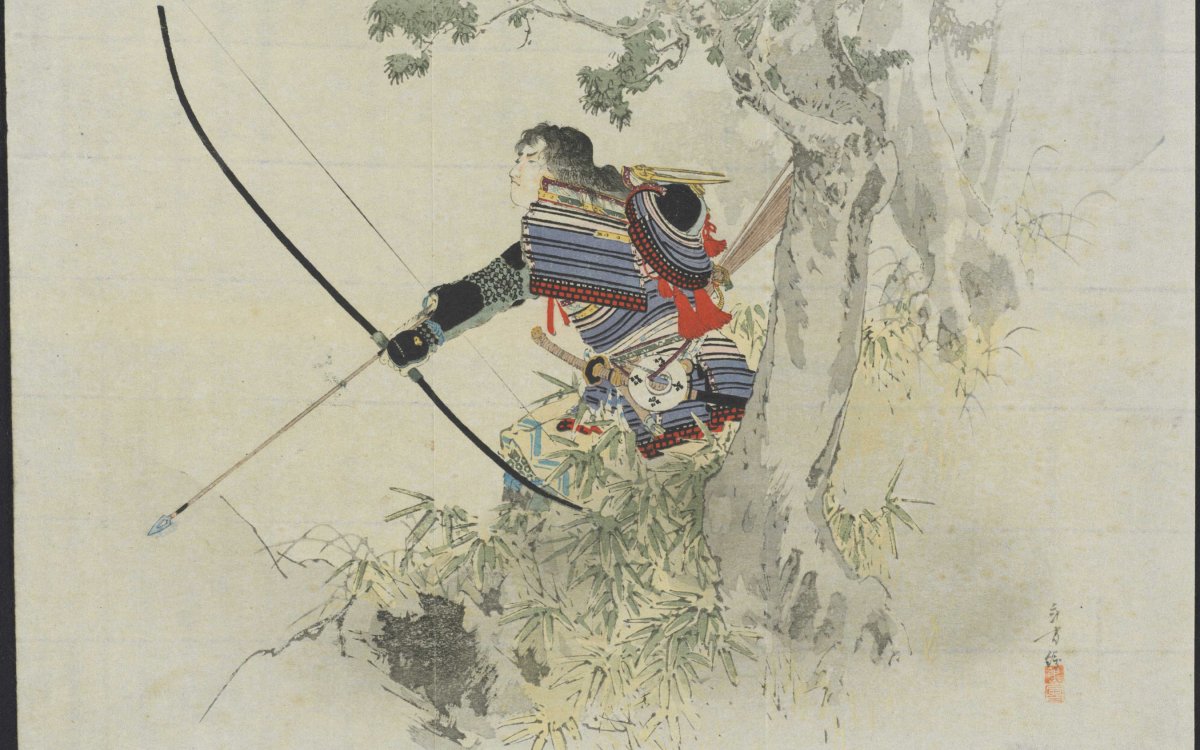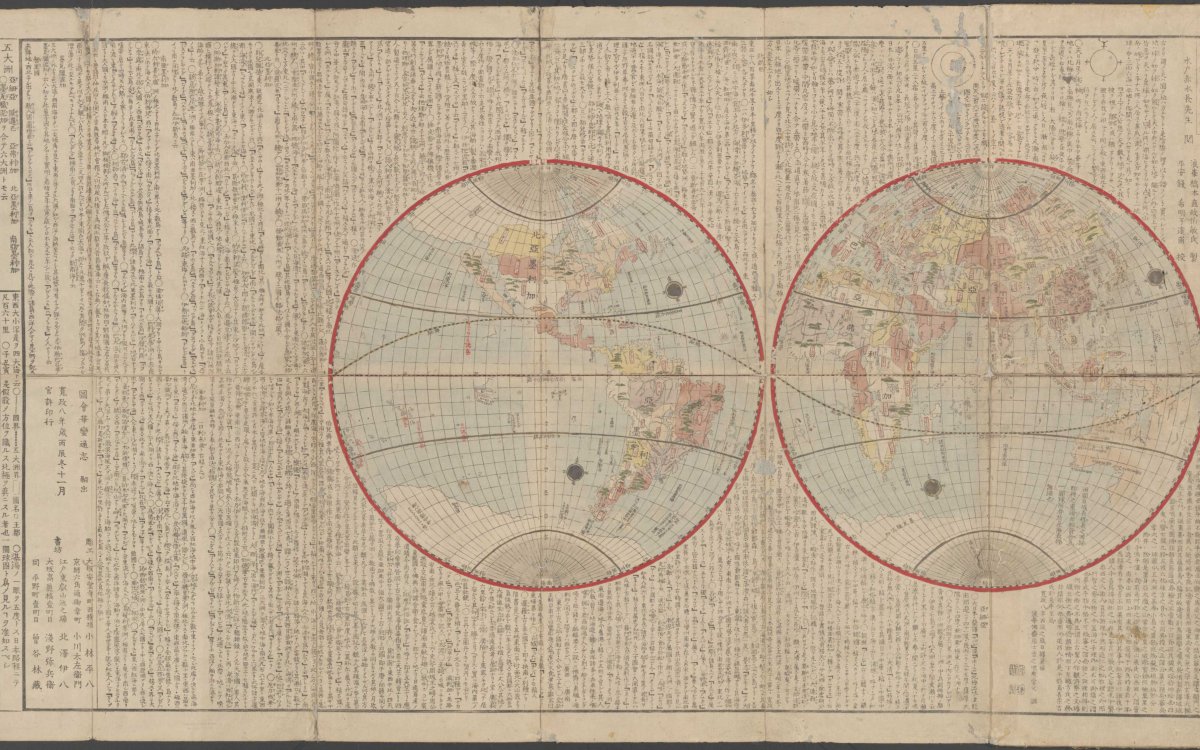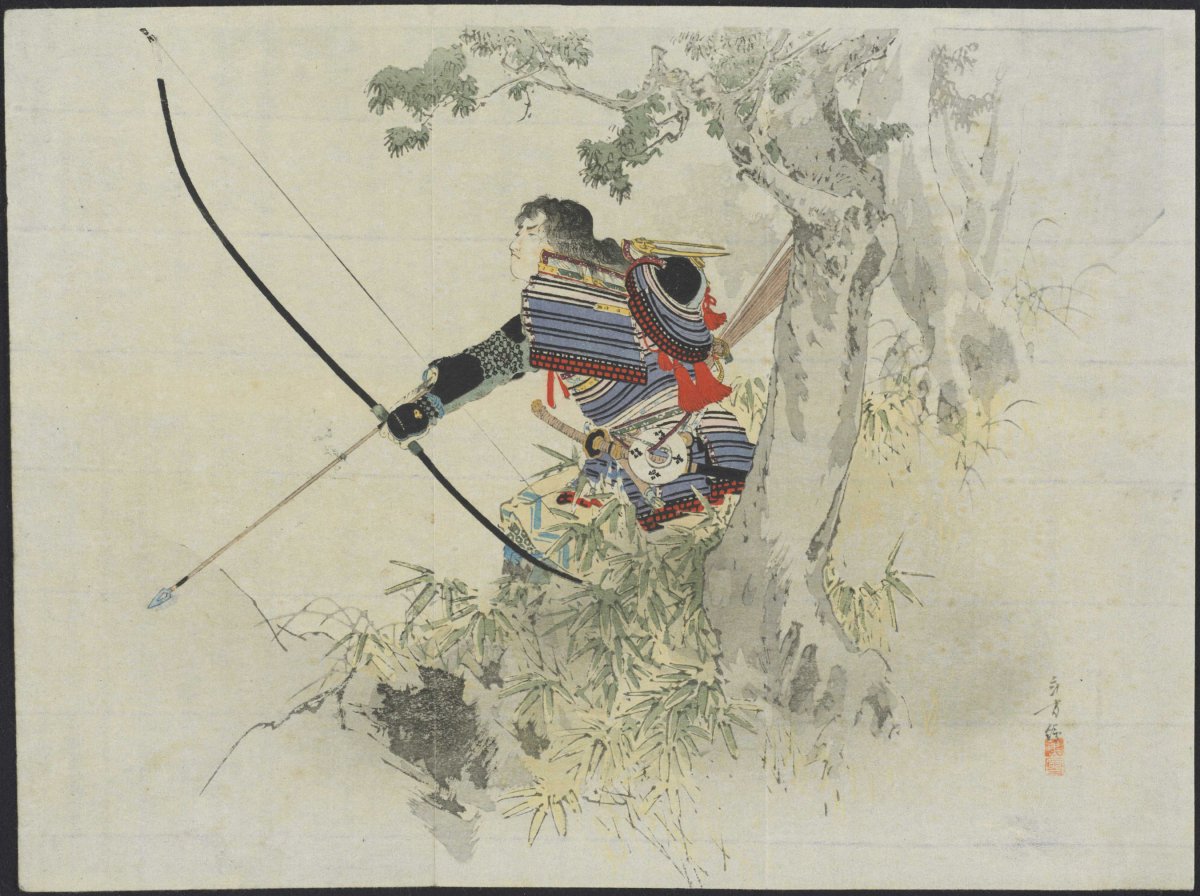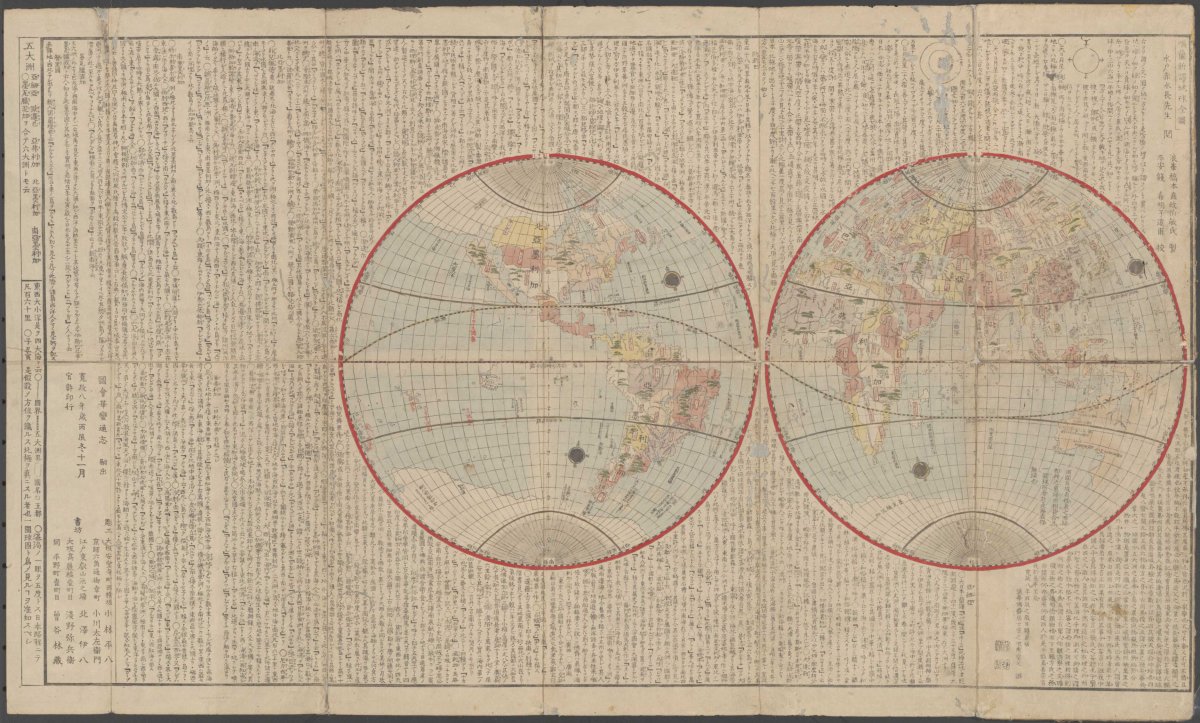
Mizuno, Toshikata, 1866-1908 & 水野年方, 1866-1908. (1899). Eishi sassō [picture]. http://nla.gov.au/nla.obj-152419290
In 1543, after being blown off course, Portuguese traders on board a Chinese merchant junk on the way to the Chinese port of Ningbo arrived on the Japanese island of Tanegashima. The Portuguese onboard, António Mota and Francisco Zeimoto, are considered the first recorded Europeans to have arrived in Japan. A third Portuguese sailor, António Peixoto, is sometimes considered to have been on the voyage but there is no documentary evidence showing he landed in Japan. This first European contact was followed in 1549 by the arrival of Spanish missionaries, intent on spreading their faith.
The European arrivals in Japan in the 1540s had a profound impact on the Japanese political landscape. At the time of the first European contact, Japan was in the midst of civil war. Europeans brought with them not only new ideas and new trade opportunities, but powerful new weaponry in the form of matchlock guns. Until this time, Japanese military strategy adhered to hand-to-hand combat with covering fire from archers, some on foot and others mounted on horses. Many daimyos saw the advantage of the new technology and began acquiring guns and setting their swordsmiths and metalworkers to producing locally made weapons. In some cases, missionaries would only trade weapons with daimyos who would convert to Christianity.
Within a few decades, gunpowder weapons were plentiful in Japan and military strategy had adapted, to devastating effect. In a campaign against the rival Takeda clan in 1575, Oda Nobunaga decimated the Takeda cavalry lines when he turned his troops, equipped with firearms, against them. Adopting this new technology was a significant factor in paving the way for Oda Nobunaga to emerge as the most powerful daimyo in Japan.
A New Faith
Europeans also brought with them new faiths. Spanish and Portuguese missionaries arrived in Japan with the intent to spread Christianity and set up missions throughout Kyushu (south-western Japan). By the end of the sixteenth century almost 300,000 Japanese people had converted to Christianity, including several leading daimyos. Oda Nobunaga was tolerant of the Christian missionaries and those who had converted; however, after his death, relations between the Japanese government and Christians became strained. Nobunaga’s successor, Toyotomi Hidoyoshi, became increasingly suspicious of Christian missionaries and their followers, believing they were acting as spies for foreign nations and that they promoted the persecution of those who followed Shinto and Buddhist beliefs. In 1587, Hidoyoshi issued an edict ordering all foreign priests to leave Japan.
A New Faith
Europeans also brought with them new faiths. Spanish and Portuguese missionaries arrived in Japan with the intent to spread Christianity and set up missions throughout Kyushu (south-western Japan). By the end of the sixteenth century almost 300,000 Japanese people had converted to Christianity, including several leading daimyos. Oda Nobunaga was tolerant of the Christian missionaries and those who had converted; however, after his death, relations between the Japanese government and Christians became strained. Nobunaga’s successor, Toyotomi Hidoyoshi, became increasingly suspicious of Christian missionaries and their followers, believing they were acting as spies for foreign nations and that they promoted the persecution of those who followed Shinto and Buddhist beliefs. In 1587, Hidoyoshi issued an edict ordering all foreign priests to leave Japan.
Westerners and other foreigners were tolerated to varying degrees in the years following their arrival but by the early years of the Tokugawa Shogunate, Japanese foreign policy began to turn inwards. Officials increasingly viewed foreign traders and missionaries as potential spies or traitors and saw the potential for Japanese trade power to diminish with competition from China. To combat these fears, Tokugawa Ieyasu’s grandson, Iemitsu, issued a series of Exclusion Acts in the 1630s, which would come to be known as sakoku (鎖国 – Closed Country).
Of the Exclusion Acts issued by the Tokugawa Government, some of the most aggressive policies included:
· Forbidding any foreign ships to enter Japanese waters, with the exception of Dutch, Chinese and Korean traders.
· Forbidding Japanese citizens from leaving Japan.
· Forbidding Japanese citizens living abroad from returning.
· Prohibiting the building of vessels large enough to cross oceans.
· Persecution of Japanese scholars researching western ideas.
· Restricting the population of Chinese traders to 2,000 and confining them to a neighbourhood of Nagasaki.
· Confining Dutch traders to the man-made island of Deshima in Nagasaki harbour.
· Forbidding foreign traders from learning Japanese or procuring information (such as maps) about Japan.
Of the Exclusion Acts issued by the Tokugawa Government, some of the most aggressive policies included:
· Forbidding any foreign ships to enter Japanese waters, with the exception of Dutch, Chinese and Korean traders.
· Forbidding Japanese citizens from leaving Japan.
· Forbidding Japanese citizens living abroad from returning.
· Prohibiting the building of vessels large enough to cross oceans.
· Persecution of Japanese scholars researching western ideas.
· Restricting the population of Chinese traders to 2,000 and confining them to a neighbourhood of Nagasaki.
· Confining Dutch traders to the man-made island of Deshima in Nagasaki harbour.
· Forbidding foreign traders from learning Japanese or procuring information (such as maps) about Japan.
In theory, sakoku shuttered Japan from the outside world. In reality, outside information and goods still arrived in Japan, but it was much easier to control and, should it prove disagreeable to the government, mitigate and shut down.

Hashimoto, Sōkichi, 1763-1836 & 橋本宗吉, 1763-1836 & Nagakubo, Sekisui, 1717-1801 & 長久保赤水, 1717-1801. (1796). Oranda shinyaku chikyū zenzu [cartographic material] / Hashimoto Naomasa sei ; chōkō Kobayashi Heihachi, Ogawa Tazaemon; Mito sekisuichō etsu. http://nla.gov.au/nla.obj-232371885
Rangaku – Dutch Learning
While initially skirting the bakufus’ policy of censoring western interference, Japanese scholars studied the texts and learnings of European engineers and academics that arrived in Japan with the Dutch traders. This study became known as Rangaku (蘭学 – Dutch learning) taken from part of the Japanese word for Holland (阿蘭陀 – Oranda) and gaku ( 学 – learning/study). Through the study of maps, medical journals and schematics of machinery, the Japanese gradually built up a theoretical understanding of industrial technology, although manufacture and implementation of this technology was not as prevalent. Many advances, such as electricity and hot air balloons, were seen as novelties rather than practical science. Initially tightly controlled by the bakufus, the restrictions on western learning were gradually relaxed by the early 1700s. However, by the 1800s scholars of western ideas began to question Japan’s closure to the rest of the world.
Rangaku – Dutch Learning
While initially skirting the bakufus’ policy of censoring western interference, Japanese scholars studied the texts and learnings of European engineers and academics that arrived in Japan with the Dutch traders. This study became known as Rangaku (蘭学 – Dutch learning) taken from part of the Japanese word for Holland (阿蘭陀 – Oranda) and gaku ( 学 – learning/study). Through the study of maps, medical journals and schematics of machinery, the Japanese gradually built up a theoretical understanding of industrial technology, although manufacture and implementation of this technology was not as prevalent. Many advances, such as electricity and hot air balloons, were seen as novelties rather than practical science. Initially tightly controlled by the bakufus, the restrictions on western learning were gradually relaxed by the early 1700s. However, by the 1800s scholars of western ideas began to question Japan’s closure to the rest of the world.
While aggressive, the Closed Country policy was a major factor in the long-lived stability and relative peace of the Edo period.
Activities
- What are the potential dangers of closing a country to the outside world?
- Imagine you are scholar who has been given a book full of new technology and inventions by a Dutch trader that could be very useful, but you know the Shogun isn’t happy about new ideas. Choose an invention or technology and write a persuasive letter to the Shogun outlining why he should consider letting you introduce the new technology.

